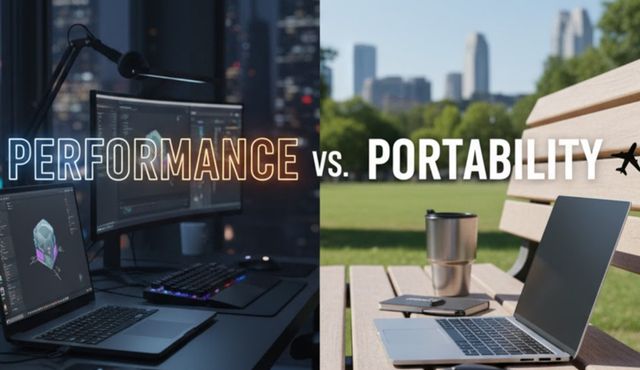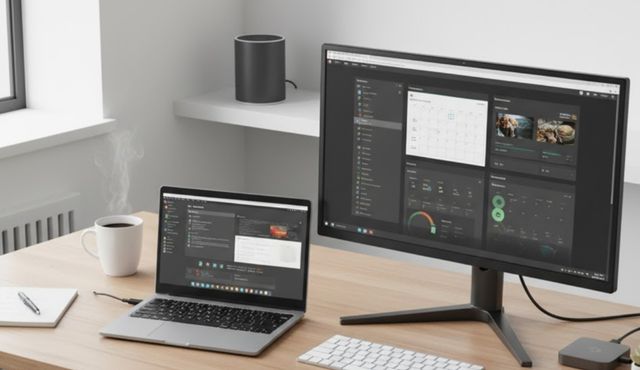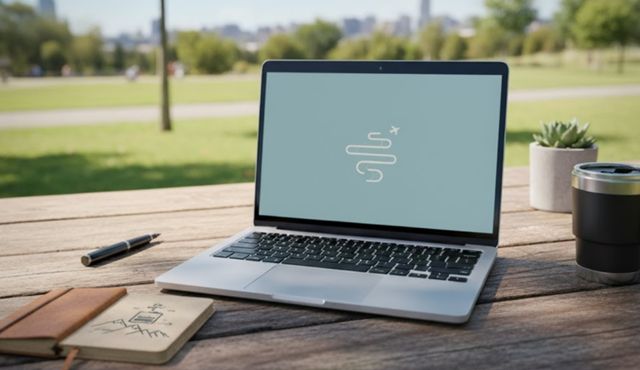11-Inch Laptop for Portability Over Power: What to Consider?
Compact computing has revolutionized how professionals work on the go. An 11-inch laptop offers unmatched portability while requiring careful consideration of compromises.
These pocket-sized powerhouses weigh under 3 pounds and slip into any bag, making them ideal for travelers, students, and remote workers. Understanding the balance between lightweight design and functional performance helps you choose the right device.
This guide explores essential features, realistic performance expectations, and optimization strategies. Discover how to maximize productivity without sacrificing convenience.
Why Choose an 11-Inch Laptop?
Selecting the right portable computer involves understanding what makes compact devices appealing for specific lifestyles and work patterns.
Ultimate Portability Benefits
The primary advantage of an 11-inch laptop centers on extreme portability. These devices typically weigh between 2 to 2.8 pounds, making them significantly lighter than traditional 15-inch models that often exceed 5 pounds. The compact footprint fits comfortably in backpacks, messenger bags, and even large purses.
Business travelers appreciate how easily these laptops slide into airplane tray tables. The smaller dimensions allow comfortable typing even in cramped spaces like coffee shops or public transportation.
Ideal Use Cases
An 11-inch laptop excels at specific tasks rather than serving as an all-purpose workstation. Web browsing, document editing, email management, and video streaming represent the sweet spot for these machines. Students taking notes during lectures benefit from the lightweight design.
Remote workers handling basic productivity tasks find these devices perfectly adequate. However, graphic designers, video editors, and software developers typically need more processing power and screen real estate.
Budget-Friendly Options
Compact laptops often cost less than their larger counterparts. Many quality models start around \$200 to \$600, making them accessible entry points for budget-conscious buyers. The lower price reflects both the smaller components and targeted feature sets.
This affordability makes 11-inch laptops excellent secondary devices for households already owning desktop computers. You can also sell electronic items you no longer need to offset the purchase cost.
Top Features to Look For When Choosing an 11-Inch Laptop
Understanding critical specifications helps identify models that match your requirements without unnecessary compromises.
Display Quality and Resolution
Screen quality matters tremendously on compact devices. Look for at least HD resolution (1366×768) as a minimum standard, though 1920×1080 Full HD provides noticeably sharper text and images. IPS panels offer better viewing angles compared to TN displays.
Touchscreen capability adds versatility, especially for convertible 2-in-1 designs. However, touchscreens increase weight and reduce battery life slightly. Glossy screens show colors vibrantly but reflect ambient light, while matte finishes minimize glare.
Brightness levels between 250-300 nits work adequately for indoor use. Higher brightness becomes essential if you frequently work outdoors or in brightly lit environments.
Processor and RAM Considerations
Most 11-inch laptops feature energy-efficient processors rather than high-performance chips. Intel Celeron and Pentium processors handle basic tasks adequately, while Core i3 or AMD Ryzen 3 chips provide better multitasking capability. If you plan to sell Dell laptop models to upgrade, consider processors that maintain resale value.
RAM capacity directly impacts multitasking smoothness. Aim for at least 4GB as an absolute minimum, though 8GB provides noticeably better performance. Many budget models ship with 4GB soldered RAM that cannot be upgraded later.
Chrome OS devices manage resources differently from Windows laptops. Chromebooks with 4GB RAM often perform comparably to Windows machines with 8GB.
Storage Solutions
Storage type affects both speed and capacity. eMMC storage appears in most budget 11-inch laptops, offering faster performance than traditional hard drives but slower than SSDs. Expect 32GB to 64GB capacity in entry-level models.
SSD storage represents a significant upgrade, providing faster boot times and application loading. Models with 128GB or 256GB SSDs cost more but deliver substantially better responsiveness. Cloud storage services help compensate for limited local capacity.
Consider your actual storage needs realistically. If you primarily stream content and store files in cloud services, smaller storage suffices.
Battery Life Expectations
Compact laptops excel at battery efficiency due to lower-power components. Quality models deliver 6 to 10 hours of real-world usage for web browsing and document work. Manufacturers’ claims often exceed actual performance by 20-30%.
Battery capacity ranges from 35Wh to 45Wh in this category. Larger batteries add weight, creating a trade-off between runtime and portability. Different categories of laptop users prioritize battery life differently based on usage patterns.
Factors affecting battery longevity include screen brightness, wireless connectivity, and running applications. Power-efficient ARM-based processors in some newer models extend runtime significantly.
Build Quality and Keyboard Comfort
Construction materials impact durability and feel. Plastic chassis dominate budget models, offering adequate protection at minimal weight. Metal construction adds rigidity and a premium feel but increases cost.
Keyboard quality suffers more on compact devices due to space constraints. Key travel typically measures 1.0mm to 1.5mm, less than the 1.5mm to 2.0mm found on larger laptops. Test typing comfort before purchasing when possible.
Trackpad size and responsiveness matter for productivity. Look for multi-touch capable trackpads measuring at least 3.5 inches diagonally. Budget models often include mediocre trackpads that frustrate daily use.
Connectivity Ports
Limited physical space restricts available ports on 11-inch laptops. Most models include 2-3 USB ports, with at least one USB-C becoming standard. HDMI output enables external display connectivity.
SD card slots provide storage expansion options. Some ultraportable models eliminate traditional ports entirely, relying solely on USB-C with dongle adapters. Consider your peripheral needs carefully.
Wireless connectivity should include Wi-Fi 5 (802.11ac) minimum, with Wi-Fi 6 offering better performance and future-proofing. Bluetooth 4.2 or higher enables wireless peripherals.
Performance vs Portability: The Trade-Off

Understanding realistic performance limitations prevents disappointment and helps set appropriate expectations.
Processing Power Limitations
The fundamental compromise with 11-inch laptops involves processing capability. Energy-efficient processors prioritize battery life over raw performance. Single-core tasks like web browsing work smoothly, but heavy multitasking reveals limitations.
Expect slower performance than desktop replacements or gaming laptops. Applications launch more gradually, and switching between multiple programs shows occasional lag. Video encoding, photo editing, and gaming push these machines beyond comfortable limits.
However, for intended use cases, performance proves adequate. Document editing, spreadsheet work, and video streaming run without issues.
Graphics Capabilities
Integrated graphics handle basic visual tasks but struggle with demanding applications. Casual gaming of older or less intensive titles works acceptably. Modern AAA games remain largely unplayable at decent settings.
Video playback works smoothly for streaming services at 1080p resolution. Some models handle 4K video playback, though battery drains faster. External monitor support typically maxes at 1080p or 2560×1440 resolution.
Graphics-intensive workflows like video editing or 3D modeling require larger, more powerful laptops. The 11-inch category prioritizes mobility over creative workstation capability.
Thermal Management
Compact chassis limits cooling solutions, affecting sustained performance. Passive cooling in fanless models runs silently but throttles performance during extended workloads. Active cooling with small fans maintains better performance but generates audible noise.
Heat management improves with an aluminum chassis that dissipates warmth more effectively than plastic. Expect the bottom surface to feel warm during intensive tasks.
Performance throttling prevents overheating but reduces processing speed. This becomes noticeable during video calls or when running multiple applications simultaneously.
Upgrade Limitations
Most 11-inch laptops offer minimal upgrade potential. RAM typically comes soldered to the motherboard, preventing future expansion. Storage might be replaceable on some models, but many use soldered eMMC chips. When searching for Dell laptop online models, check specifications carefully for upgrade possibilities.
This fixed configuration makes initial purchase decisions more critical. Choose specifications that meet anticipated needs for the device’s entire lifespan. Budget permitting, opt for higher RAM and storage initially.
Some Chromebooks automatically update but have predetermined end-of-life dates after which they stop receiving security patches.
Tips for Maximizing Your 11-Inch Laptop Experience
Strategic approaches optimize compact laptop functionality and extend usability.
External Peripherals and Accessories
A USB hub dramatically expands connectivity options, adding multiple USB ports, HDMI output, SD card readers, and Ethernet. Choose hubs that match your laptop’s USB-C or USB-A ports.
External monitors transform productivity by providing additional screen space. A 24-inch display at home or office complements portable computing power. Wireless keyboards and mice improve ergonomics for extended work sessions.
Laptop stands elevate screens to comfortable viewing heights, reducing neck strain. Cooling pads with built-in fans help manage thermals during intensive tasks.
Software Optimization Strategies
Choose lightweight applications that consume fewer resources. Web-based alternatives often work better than installed desktop software. Google Workspace, Microsoft Office Online, and similar cloud services reduce local processing demands.
Disable unnecessary startup programs that consume RAM and processing power. Regular maintenance, including disk cleanup and defragmentation, keeps Windows machines running smoothly.
Browser extensions should be minimized as they consume memory. Close unused tabs and applications to free resources for active tasks.
Cloud Storage Integration
Leverage cloud services to overcome limited internal storage. Google Drive, Dropbox, OneDrive, and iCloud provide free storage tiers sufficient for many users. Sync only essential files locally while keeping archives in the cloud.
Streaming services for music and video eliminate the need for local media libraries. This approach requires reliable internet connectivity but maximizes available storage for working files.
Consider offline access settings carefully. Selectively download critical documents for offline availability while keeping most files cloud-only.
Battery Conservation Techniques
Reduce screen brightness to comfortable minimum levels, as displays consume significant power. Enable power-saving modes that limit background processes and reduce performance slightly.
Wireless connectivity drains battery when actively searching for networks. Disable Wi-Fi and Bluetooth when not needed. Close resource-intensive applications running in the background.
Avoid extreme temperatures that degrade battery health. Keep the laptop in moderate temperature environments and avoid leaving it in hot cars or cold environments.
Frequently Asked Questions

Can an 11-Inch Laptop Replace a Desktop Computer?
For basic computing needs, an 11-inch laptop can serve as your primary device. If your tasks involve web browsing, document editing, email, and streaming media, compact laptops provide adequate performance.
However, gaming, video editing, programming, and other intensive workflows require more powerful hardware. Consider your specific usage patterns before committing to a single device.
How Long Do 11-Inch Laptops Typically Last?
Quality 11-inch laptops last approximately 3 to 5 years with proper care. Battery degradation becomes noticeable after 2-3 years, reducing runtime by 20-30%. Software requirements increase over time, making older hardware feel slower.
Physical durability depends on build quality and usage intensity. Budget models typically have shorter lifespans than premium alternatives due to component quality.
Are 11-Inch Laptops Good for Students?
Students benefit significantly from 11-inch laptop portability, especially when carrying devices between classes. These machines handle note-taking, research, paper writing, and online coursework effectively.
STEM students running specialized software or engineering programs may need more powerful options. Business and liberal arts students find compact laptops perfectly adequate for academic requirements.
What Operating System Works Best on 11-Inch Laptops?
Chrome OS excels on 11-inch hardware due to its lightweight resource requirements. These devices boot quickly and run smoothly with modest specifications.
Windows 10 or 11 requires more robust hardware but offers broader software compatibility. Linux distributions provide excellent performance on older or lower-spec hardware. Consider your software needs when choosing operating systems.
Make the Right Choice for Your Needs
Selecting an 11-inch laptop requires an honest assessment of your computing requirements and mobility priorities. These compact devices deliver exceptional portability at the cost of processing power and screen size.
For travelers, students, and professionals needing secondary machines, they represent ideal solutions. Carefully evaluate specifications, understand performance limitations, and implement optimization strategies. The perfect portable laptop balances your actual needs against realistic capabilities.



One Response
I’ve been trying to choose between portability and power for a while now, and after reading this, I feel like I have a better idea of where I stand. For anyone traveling often, the smaller laptop seems like the clear winner, but I’m curious how much you’d actually sacrifice in terms of performance for things like streaming or casual gaming?